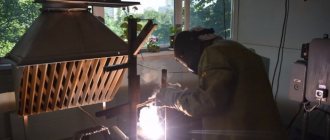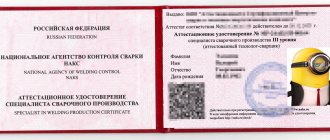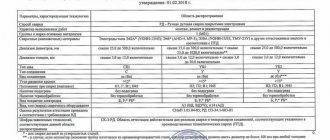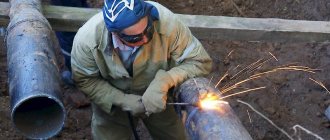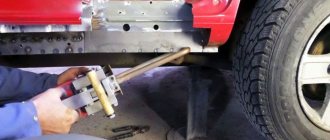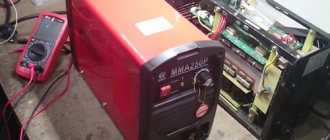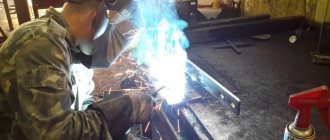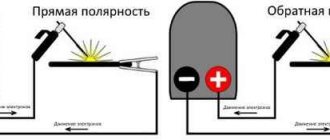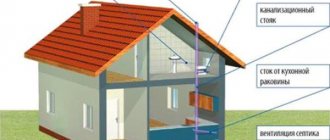general information
NAKS is the National Welding Control Agency. It was created less than 10 years ago, but has already proven itself as an effective tool for monitoring welding enterprises. Certification is carried out by specialists from certified centers. Such centers are opened by private individuals, but inspections are carried out in accordance with NAKS certification standards.
Certification of welding equipment by NAKS (and in general any certification from the National Welding Control Agency) is carried out voluntarily. But there are exceptions when many complaints are filed against an enterprise and an inspection becomes mandatory.
There are currently about 300 NAKS centers operating in the country, so the test can be completed in most major cities. Specialists from NAKS centers certify not only equipment, but also workers, welding technologies, etc.
Certification of welding equipment by NAKS consists of testing devices for compliance with domestic and international quality standards. Thanks to the test, you can find out whether your equipment is suitable for performing critical work.
Welding equipment subject to certification
Obtaining a mandatory certificate of conformity is provided for by the technical regulations of the Customs Union “Electromagnetic compatibility of technical means” in the production of arc welding equipment (with HS codes: 8515 31 000 0, 8515 39 130 0, 8515 39 180 0, 8515 39 900 0).
Among such equipment are:
- automatic and semi-automatic machines for electric arc welding and surfacing, including automatic machines for argon-arc welding;
- automatic and semi-automatic machines for electroslag welding and surfacing;
- automatic and semi-automatic machines for electric arc welding of studs and welding with electric rivets;
- automatic and semi-automatic machines for special purposes for electric arc welding and surfacing, etc.
Why do you need a certificate?
Since the NAKS check is voluntary, then why go through it at all? Isn't it easier to just work under the same conditions as before without worrying about inspections? But the certificate will still have to be updated...
Let’s put it this way: if you are confident in the quality of your welding production, then it’s definitely worth getting certified. And if you have something to hide, then a sudden inspection from Rosgostekhnadzor will reveal your secrets in any case.
So, what does the NAKS welding equipment certification certificate provide? First of all, it confirms that you can continue to use all your welding equipment. If a mandatory government inspection comes your way, you can present your NAKS certificate and secure your enterprise.
Sample of NAKS certificate
Thanks to the certificate, you can also use certified equipment to perform any special work that you have not previously performed in your production. For example, you have equipment for argon arc welding. It has been certified and can now be used for welding particularly critical structures, for example.
Another important advantage is the ability to present a NAKS certificate for welding equipment as a guarantee of quality for your work. Such a document can be shown to business partners or other enterprises with which you want to cooperate. The certificate will be a guarantee that you are doing quality work.
The only disadvantage of certification is the bureaucratic red tape and high price. Certification is not carried out free of charge, but this requires the allocation of money from the enterprise budget.
To carry out certification for NAKS specialists, you need to provide some documents
In order to acquire NAKS certificates, you will need to prepare a package of documents, including in particular:
- Application for certification to the certification center (branch) of NAKS for certification;
- Available passports for CO;
- When you use imported welding equipment, you will need to provide a translated manual;
- Certificates for 2 employees of the enterprise working as a welder of the 5th category (with a copy of the commission protocol);
- Welding production engineer certificate (copy) - specialist level II or higher;
- Certificates of conformity for CO.
Submit an application to our manager.
Conclude an agreement and pay the invoice.
Collect and submit to us a package of documents.
We analyze and improve the qualifications of employees.
Submission of documents to the Certification Center for examination.
Drawing up a protocol and issuing a certificate.
After examination of the documents, NAKS specialists will draw up a testing program for your CO, based on the results of which NAKS Certificates will be issued on the certification and compliance of your welding equipment with the regulatory framework and in accordance with the standards RD-03-614-03.
Attestation process
First you need to submit an application. Find a NAKS certified body in your region and send a letter of application there.
In it you indicate the details of your company, as well as the list and functional properties of welding equipment that needs to be certified. Do not forget to indicate the date when the welding equipment was put into operation.
It is also recommended to indicate the production conditions and the place of manufacture of the welding machines, whether the workers have been tested, list all the parameters of the premises where the welding machines are used, the types of welding technologies and the parameters of the parts used.
Welding equipment subject to declaration
Arc welding equipment falls within the scope of regulation not only of the technical regulations of the Customs Union for electromagnetic compatibility, but also of the regulations for low-voltage equipment, which establishes the mandatory declaration of conformity of welding machines.
List of standards, as a result of which, on a voluntary basis, compliance with the requirements of the technical regulations of the Customs Union “On the safety of low-voltage equipment” (TR CU 004/2011) for welding equipment is ensured:
GOST 12.2.007.8-75 System of occupational safety standards. Devices for electric welding and plasma processing. Safety requirements,
GOST EN 50445-2013 Equipment for resistance and arc welding and related processes. Assessment of compliance with basic requirements for limiting human exposure to electromagnetic fields (0 Hz – 300 GHz)
GOST IEC 60245-6-2011 Cables with rubber insulation for rated voltages up to 450/750 V inclusive. Cables for electrode arc welding
GOST R IEC 60974-1-2012 Equipment for arc welding. Part 1. Welding current sources
GOST IEC 60974-2-2014 Arc welding equipment. Part 2. Liquid cooling systems
GOST IEC 60974-3-2014 Arc welding equipment. Part 3. Arc ignition and stabilization devices
GOST IEC 60974-5-2014 Arc welding equipment. Part 5. Wire feed mechanism
GOST IEC 60974-7-2015 Equipment for arc welding. Part 7. Burners
GOST IEC 60974-8-2014 Arc welding equipment. Part 8. Gas supply consoles for welding and plasma cutting systems
GOST IEC14 Equipment for arc welding. Part 11. Electrode holders
GOST IEC14 Equipment for arc welding. Part 12: Connectors for welding cables
Declaration of conformity of welding equipment is also enshrined in the Technical Regulations of the Customs Union “On the safety of machinery and equipment”.
Equipment for welding and thermal spraying (from the group of HS codes 8468 and 8515).
The mandatory document on the basis of which a declaration of conformity with TR CU 010/2011 is accepted is a “safety justification” - a document containing a risk analysis, as well as information from design, operational, and technological documentation on safety measures.
A list of standards, as a result of which, on a voluntary basis, compliance with the requirements of the technical regulations of the Customs Union “On the safety of machinery and equipment” (TR CU 010/2011) is ensured, in terms of equipment for gas-flame processing of metals and metallization of products.
| Section 4 GOST 31596-2012 (ISO 9090:1989) | Tightness of equipment and apparatus for gas welding, cutting and similar processes. Permissible rates of external gas leakage and method of their measurement |
| Section 6 GOST R 50402-2011 (ISO 5175:1987) | Equipment for gas welding, cutting and related processes. Safety devices for flammable gases and oxygen or compressed air. Technical requirements and tests |
| sections 1 – 9 GOST 12.2.008-75 | System of occupational safety standards. Equipment and equipment for gas-flame processing of metals and thermal spraying of coatings. Safety requirements |
| sections 1 – 4 GOST 12.2.052-81 | System of occupational safety standards. Equipment working with oxygen gas. General safety requirements |
| sections 1 – 7 GOST 12.2.054-81 | System of occupational safety standards. Acetylene units. Safety requirements |
| Section 3 GOST 1077-79 | Single-flame universal torches for oxy-acetylene welding, soldering and heating. Types, main parameters and dimensions and general technical requirements |
| section 3 GOST 5191-79 | Injection cutters for manual oxygen cutting. Types, main parameters and general technical requirements |
| Section 5 GOST 13861-89 | Gearboxes for gas-flame processing. General technical conditions |
| section 5 GOST 30829-2002 | Mobile acetylene generators. General technical conditions |
| sections 5 and 6 GOST R 54791-2011 | Equipment for gas welding, cutting and related processes. Reducers and flow meters for gas pipelines and gas cylinders with gas pressure up to 300 bar (30 MPa). |
Regarding equipment for welding and thermal spraying
| sections 1 – 9 GOST 12.2.008-75 | System of occupational safety standards. Equipment and equipment for gas-flame processing of metals and thermal spraying of coatings. Safety requirements |
| GOST 21694-94 | Mechanical welding equipment. General technical conditions |
| GOST 30275-96 | Manipulators for contact spot welding. General technical conditions |
Regarding complexes for mechanical engineering and flexible production modules
| Section 4 GOST 26056-84 | Industrial robots for arc welding. General technical conditions |
It is mandatory to register a declaration before releasing the following devices into circulation:
- equipment for manual welding;
- welding inverters;
- welding units;
- resistance spot welding machines;
- machines for seam resistance welding and projection welding;
- multi-electrode, suspended machines;
- resistance butt welding equipment;
- welding pliers;
- equipment for gas welding;
- welding generators, etc.
Action plan
Let's imagine that your application has been reviewed and a review date has been set. What happens after? In this field you need to determine the type of check that should be performed.
There are the following types of certification of welding equipment: initial, extraordinary, periodic, and additional.
So, the initial check is performed for the first time on your declared welding equipment.
To carry out an extraordinary inspection, the initiative must be submitted by Gostekhnadzor. This check does not require your consent. The reason may be the discovery of a serious violation of standards or repeated complaints against your company.
Periodic checks are carried out at your request, always every three years.
Well, if the scope of activity of welding equipment changes, and periodic certification will not happen soon, additional certification should be carried out.
Professionals will arrive at your enterprise and, using various control methods, will give a fair assessment of the serviceability of your equipment and its compliance with its standards.
If all standards at your production are met, you will be awarded a NAKS certificate, regardless of the type of inspection.
Levels of certified workers
There are four levels at which certification is carried out.
- Level No. 1 is a NAKS welder. That is, the go-ahead is given for welding of critical structures.
- Level No. 2 is a master welder. This specialist can monitor the welding process and give instructions on correctly carried out operations. Directions may be oral or written.
- Level No. 3 is a technologist. Basically, technologists control all welding processes at enterprises.
- Level No. 4 – engineers. These are the managers of welding services who approve the documentation regulating welding processes.
It should be noted that welding equipment and tools are certified by NASK. That is, the agency also controls the quality of the equipment used, which confirms the ability to weld critical structures.
Welders undergo three types of certification:
- Primary.
- Repeatedly when the time comes to complete the NAKS courses.
- Extraordinary. This can happen if a higher organization has doubts about the welder’s qualifications.
The purpose of the NASK certification has two points: to check the readiness of the company that is engaged in welding, and to confirm the qualifications of the company’s employees authorized to carry out complex welding work.

